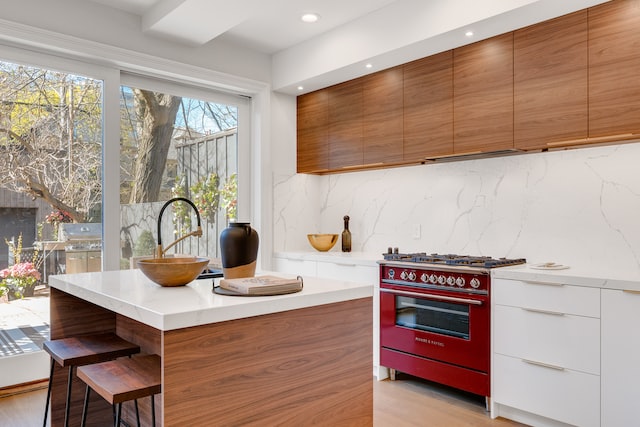
A good kitchen is a great place to enjoy time with family while cooking. Good kitchen lighting can make a cozy kitchen. The first thing you will need to consider when planning your kitchen is the actual lighting, as electrics and fittings need to be installed at the beginning of the project before plastering, decorating, and fitting. It’s a fundamental element of any scheme, your only opportunity to correct it.
The key to some successful schemes is based on layering the results, so you should attempt to zone the lighting based on its use — working (job), dining as well as mood (ambient), and making the wow element (feature). You need to concentrate on all three and think about dimmable solutions for much more flexibility.
‘Plan the lighting when you’re interested in the plumbing, advises Sally Storey, style director at Steve Cullen Lighting. ‘As a guideline, allow as much plan for your lighting as you would the floors. The size of the space determines your choices, regardless of whether your room includes a high or reduced ceiling. ‘
Setting up ceiling lighting may pose some issues, but it can be done to illuminate a kitchen without needing any ceiling lighting. An array of spotlights, down-lighters, lighters, and strips may be placed either under or along with kitchen units. It also means you may be more creative, as it is possible to conceal fixtures and fittings.
Kitchen Work Lighting
Every kitchen, no matter what size or small, requires efficient task illumination. This is just as much from a safety perspective as anything otherwise. You’ll need immediate lighting wherever any preparing food is taking location – worktops, sinks, and hobs – to ensure chopping and cooking can be achieved safely and without shadows. Under-mounted options are ideal for this, and make sure to look for recessed or semi-recessed options, as exposed gentle fittings will gather grease and dirt easier.
For the hob region, choose an extractor with four or even more halogen lights and when the island is used for preparation, highlight it along with pendant lamps and recessed downlighters. These must always be controlled on a separate circuit, so be sure you talk to your electrician before installing them.
The latest trend is perfect for easy-to-use sensor-operated items. They’re extremely practical – while preparing food, you don’t need to wash your fingers whenever you have to flick the change or wave your hand while watching the sensor. Drawer and cabinet lighting may also be operated on devices, instantly coming on once the door is opened. Not only do they look excellent, but the lights also make it much easier to locate that elusive corkscrew or even pizza cutter.
Lighting for Dining
Open-plan kitchens with a dining area or individuals with a breakfast bar need a mix of adequate lighting for eating and much softer lighting for after-dinner discussion. Dining tables and island units may benefit from several overhead pendant lights (rise-and-fall versions could be moved up or even down when required), while lights and wall lights will produce a warm glow that sets the feeling.
Giuliano Digilio in the Electrical Contractors’ Organization (ECA) suggests that dining places feature warm white LEDs to produce an atmosphere while enjoyable. ‘Cool white could be too much, he says. ‘I indicate fitting LED downlighters or surface-mounted spotlights about these areas inside a warm white color to supply a relaxed atmosphere. ‘
Hugo Tugman, the founder of Architect Your House, explains the need to consider how the actual lighting in every zone will impact the adjacent areas within an open-plan layout. ‘It’s no good developing a lovely mood within the dining area whether a bright light in the kitchen ruins it, ‘they say. ‘Part of the answer lies in illumination control – systems that permit you to switch between pre-set light plans concerning situations. This enables you to have one environment for dining, an additional one for parties, one for cleaning, and so forth. ‘.
Mood Lighting
Ambient lighting is key for developing a laid-back feel, and it is essential as kitchens become the primary social space within our homes. Look concerning softer solutions, for example, dimmable wall lighting, because of decorative systems, such as shelf and in-cabinet lighting.
‘If the kitchen is a multifunctional space having a very strong residing element, then the room must get the right atmosphere, concerning the time of day time and who’s in your own home, ‘explains Graeme Cruz, a conceptual designer about Metris and 2nd Nature Kitchens. On the other hand, if your room is big, think about how you want the various zones to work together.
Mood lighting can alter the kitchen’s Ambiance from a useful preparation zone to some chill-out or enjoyable space. Plinth lighting — especially strip lighting – around a good island unit or even breakfast bar provides the illusion of flying furniture, which can produce a magical feel through the night and is ideal for wowing guests.
For those who have a period home or interesting functions, such as a well-exposed brick wall, that you’d prefer to highlight, consider accent lighting you can use to focus on the particular area or design aspect in the room.
Ambient Lighting
This is where you have the opportunity to set your kitchen area apart. The LivingAmbiance through Philips is a variety of colored lighting that may be changed to match your mood. ‘The kitchen has become the most actively used room in your home, ‘says Ashley Cruz, consumer lighting advertising manager for Philips, ‘so lighting should be a fundamental element of its design. Great lighting improves the kitchen’s functionality, appearance, and energy efficiency and impacts your well-being. Living Ambiance enables you to access various colors and shades of white to produce the mood you would like – from awesome to warm — whether entertaining buddies or cooking for that family. ‘.